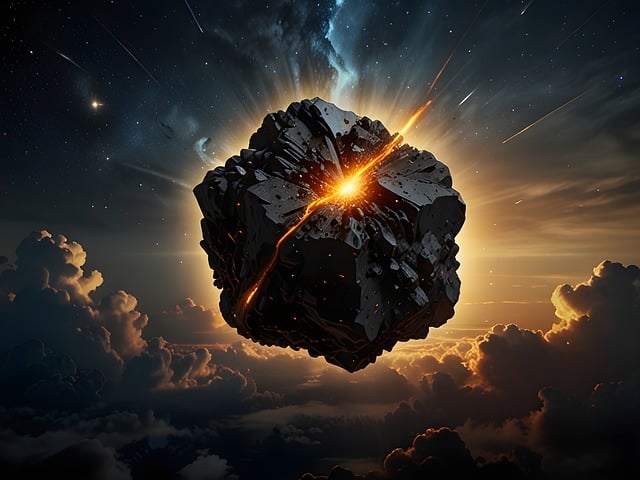The Origin of the Asteroid That Wiped Out the Dinosaurs, this mysterious cosmic event that led to the puzzled scientists for decades. The asteroid impact that occurred 66 million years ago, causing the mass extinction, has been the subject of intense research and debate. Recently, a groundbreaking study has shed new light on the origin of this catastrophic asteroid, revealing that it formed beyond Jupiter’s orbit. This discovery not only provides insights into the past but also has significant implications for understanding future threats to Earth.
The Asteroid Impact: A Historical Overview
The Chicxulub Crater
The Chicxulub crater, located in present-day Mexico’s Yucatan Peninsula, marks the site where the asteroid struck Earth. This impact triggered a series of catastrophic events, including a mega-earthquake, global wildfires, and a “nuclear winter” that drastically altered the planet’s climate. The result was the extinction of nearly 75% of Earth’s species, including the dinosaurs.
Previous Theories on the Asteroid’s Origin
For many years, scientists have speculated about the origin of the asteroid that created the Chicxulub crater. Early studies suggested that the impactor could have been a comet or an asteroid from the inner solar system. However, these theories lacked concrete evidence and left many questions unanswered.
New Insights from the Recent Study
Ruthenium Isotopes: A Key Discovery
The recent study, published in the journal Science, utilized an innovative technique to analyze sediment samples from the period between the Cretaceous and Paleogene eras. By examining isotopes of the element ruthenium, researchers were able to trace the asteroid’s origin. Ruthenium is a rare element on Earth but is more common in asteroids, making it an ideal marker for identifying extraterrestrial materials.
The Role of C-Type Asteroids
The study revealed that the Chicxulub impactor was a C-type asteroid, which is rich in carbon and formed in the outer regions of the solar system, beyond Jupiter. This finding is significant because C-type asteroids are relatively rare compared to S-type asteroids, which are more common and form closer to the Sun.
Challenging Previous Assumptions
Before this study, the idea that the Chicxulub impactor was a C-type asteroid was only a hypothesis, supported by limited evidence. The new data, however, provides a much stronger case, challenging previous assumptions and shifting the focus to the outer solar system as the likely origin of this world-altering event.
Implications of the Study
Understanding Earth’s Water
One of the most intriguing implications of this discovery is its potential to solve the mystery of how water arrived on Earth. Scientists have long debated whether water was delivered by comets or asteroids. The fact that the Chicxulub impactor was a C-type asteroid suggests that similar objects could have brought water to our planet billions of years ago.
Assessing Future Threats
The study’s findings also have practical implications for assessing future threats to Earth. Understanding the types of asteroids that have caused mass extinctions in the past can help scientists identify and monitor potential threats in the future. If a C-type asteroid were to cross Earth’s orbit again, it could pose a significant danger, making it crucial for humanity to be prepared.
Debunking the Comet Hypothesis
In addition to identifying the asteroid’s origin, the study also dismissed the theory that the Chicxulub impactor was a comet. This hypothesis, which gained attention in 2021, was based on statistical simulations rather than direct evidence. The new analysis of ruthenium isotopes showed that the impactor’s composition was not consistent with that of a comet, further solidifying the asteroid theory.
The Broader Impact of the Findings
Revisiting Mass Extinction Events
The discovery of the Chicxulub the origin of the asteroid that wiped out the dinosaurs opens the door to re-examining other mass extinction events in Earth’s history. If other extinctions were also caused by C-type asteroids, it would suggest a recurring pattern of catastrophic impacts from the outer solar system. This could lead to a better understanding of the factors that have shaped the evolution of life on Earth.
Advancing Space Exploration
The study’s findings also have implications for space exploration. By understanding the origins of asteroids that have impacted Earth, scientists can better target future missions to study similar objects in space. This could provide valuable insights into the composition and behavior of asteroids, which are key to planetary defense strategies.
A New Perspective on Cosmic Events
The revelation that the Chicxulub impactor formed beyond Jupiter challenges our understanding of the solar system’s dynamics. It raises new questions about how objects from the outer solar system can end up on collision courses with Earth. This new perspective could lead to further discoveries about the movement and interaction of celestial bodies.
Conclusion
The recent study on the origin of the asteroid that caused the extinction of the dinosaurs is a landmark discovery in the field of planetary science. By pinpointing the impactor’s formation beyond Jupiter, researchers have not only solved a long-standing mystery but also provided valuable insights into the history of our planet and the potential threats it faces. This knowledge could prove crucial in protecting Earth from future catastrophic events
FAQs
1. What was the Chicxulub impactor?
The Chicxulub impactor was an asteroid that struck Earth 66 million years ago, leading to the mass extinction that wiped out the dinosaurs.
2. Where did the Chicxulub impactor originate?
Recent studies suggest that the Chicxulub impactor originated beyond Jupiter’s orbit, making it a C-type asteroid from the outer solar system.
3. How did scientists determine the origin of the Chicxulub impactor?
Scientists used ruthenium isotopes found in sediment samples to trace the asteroid’s origin, revealing it as a C-type asteroid from beyond Jupiter.
4. Could similar asteroids threaten Earth in the future?
Yes, understanding the types of asteroids that have caused past extinctions can help scientists monitor and prepare for potential future threats from similar objects.
5. Was the Chicxulub impactor a comet?
No, the study dismissed the comet hypothesis, showing that the Chicxulub impactor was an asteroid, not a comet.


